Multiplication: Trays of arrays
View Sequence overviewIn multiplication, factors can be partitioned and distributed to make partial products. Partitioning factors to create well-known multiplication facts, such as multiples of ten, is particularly helpful. The partial products are then added together to find the product of the original multiplication. This property is known as the distributive property of multiplication.
Whole class
Trays of arrays PowerPoint
Each group
Blank A3 paper
Bread roll array picture, printed on A4 paper and cut in half
Task
Use Trays of arrays PowerPoint to continue the story of the reSolve Bakery. Show students the illustration on slide 10.
Revise the previous task: We can calculate the total number of objects in an array by partitioning the large array into smaller arrays. The total number of objects in the smaller arrays are then added together to find the total number of objects in the large array.
Show the picture of the bread roll array on slide 11.
Each day, four different types of bread rolls are made in the reSolve Bakery.
Pose the task: How might you partition the larger array into smaller arrays to determine how many bread rolls there are altogether?
Provide each pair with a sheet of A3 paper to create a poster of their solutions strategies. Also provide access to Bread roll array picture to use if they choose.
Encourage students to think of different ways they might partition the large array of bread rolls into smaller arrays. Students should record the different solutions that they come up with on their poster, along with the following information:
- At least two different ways that the large array can be partitioned into smaller arrays.
- Which partitioning method is their preferred strategy for working out the total in the collection and why.
Take note of the ways that students are partitioning the larger array.
- Are the students partitioning the smaller arrays of bread rolls or are they looking at the larger array of rolls? Prompt students to think about how they might partition the large array.
- Are students identifying known multiplication facts and partitioning the array based on these facts? Prompt students to consider the multiplication facts that they know well and how they might use these facts to help them find out how many bread rolls there are altogether.
Also observe whether students apply their understanding from Task 1 to this task.
- Do students partition the full array and add together all the partial products formed to find the total?
- What multiplication facts do you know? Which ones can be found by partitioning the larger array?
- Students can use any multiplication facts based on multiples of 1, 2, 3 and 4.
- Which multiplication facts cannot be found by partitioning the larger array?
- It is not possible to create facts like 5 x 10 or 10 x 10 just by partitioning the larger array. The arrays would need to be partitioned and then rearranged.
- Which is your preferred way of partitioning the array to find the total number of bread rolls?
- Students’ answers should be focused on finding arrays of well-known facts in the larger array. Partitioning numbers based on place value is very efficient.
The distributive property
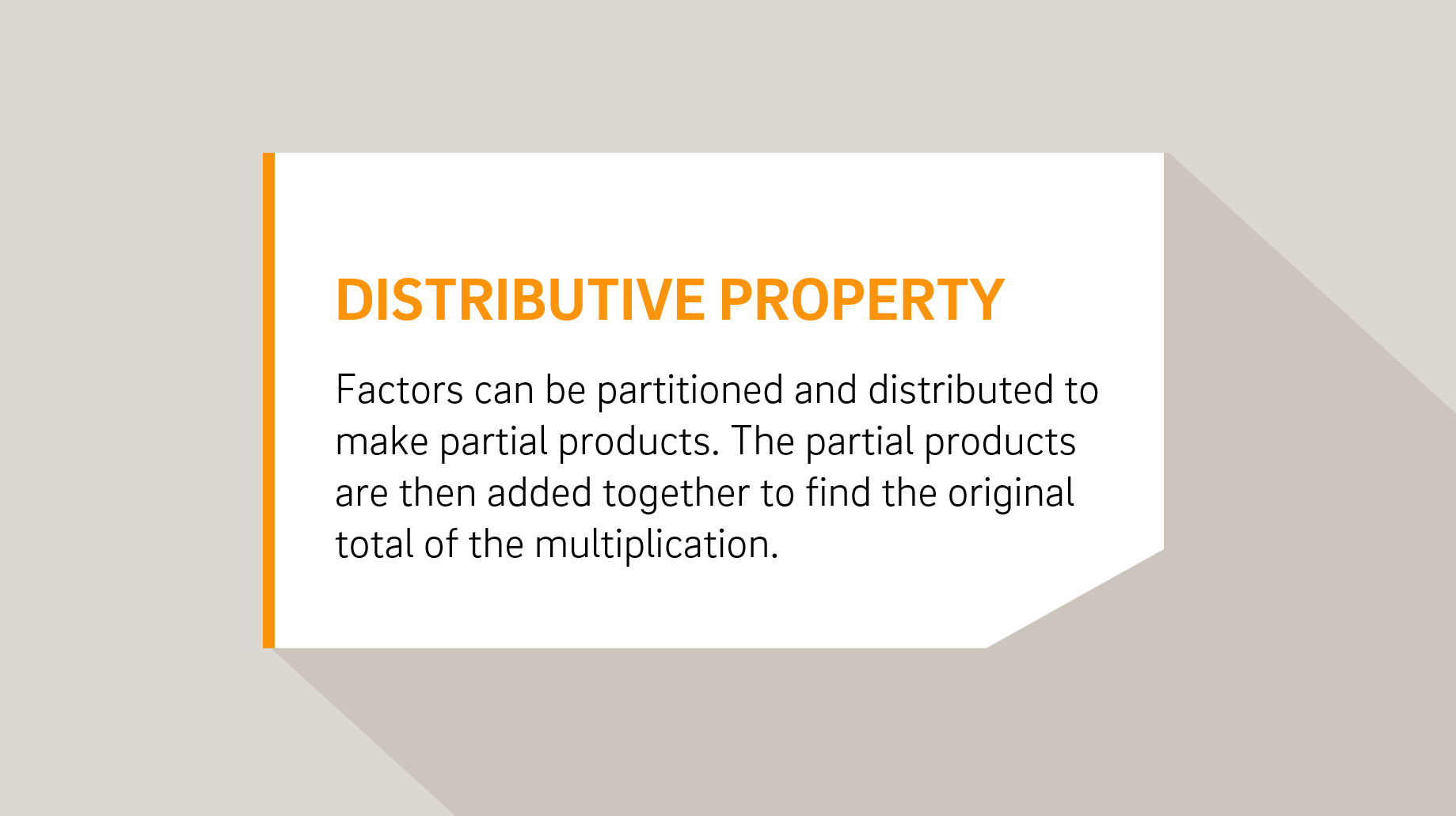
Students are asked to partition the array into smaller parts to solve this problem. They are being asked to apply the distributive property of multiplication. The distributive property is a fundamental arithmetic property of our number system.
In multiplication, numbers can be partitioned and distributed to make partial products. The partial products are then added together to find the original total of the multiplication. This is known as the distributive property of multiplication.
This can be expressed algebraically as:
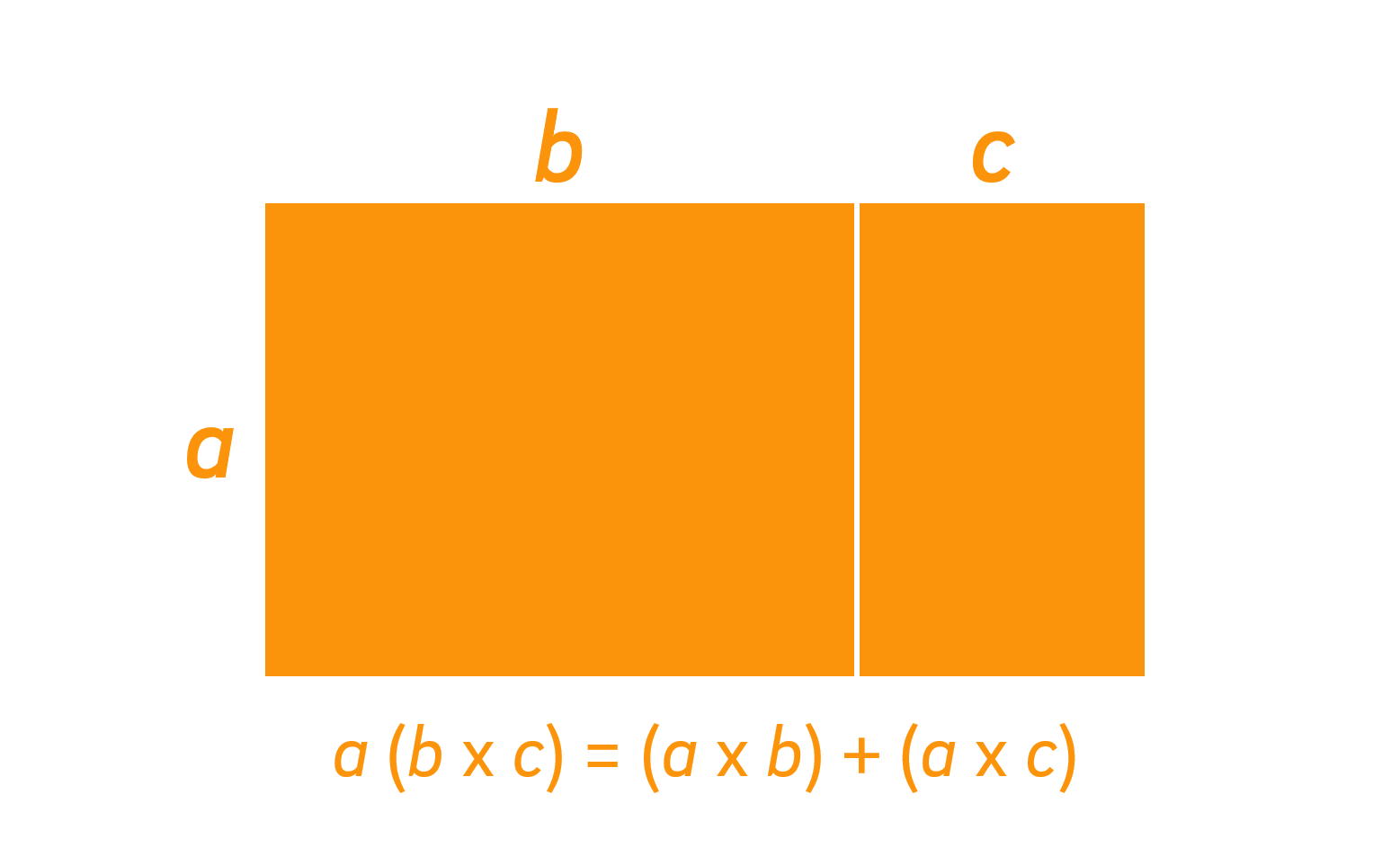
Let’s consider the distributive property applied to $12 \times 4$:
12 can be partitioned into $10 + 2$. Each part is then multiplied by 4. The partial products formed are then added together to find the total.
This can be represented using following equation:
$$12 \times 4 = (10 \times 4) + (2 \times 4)$$
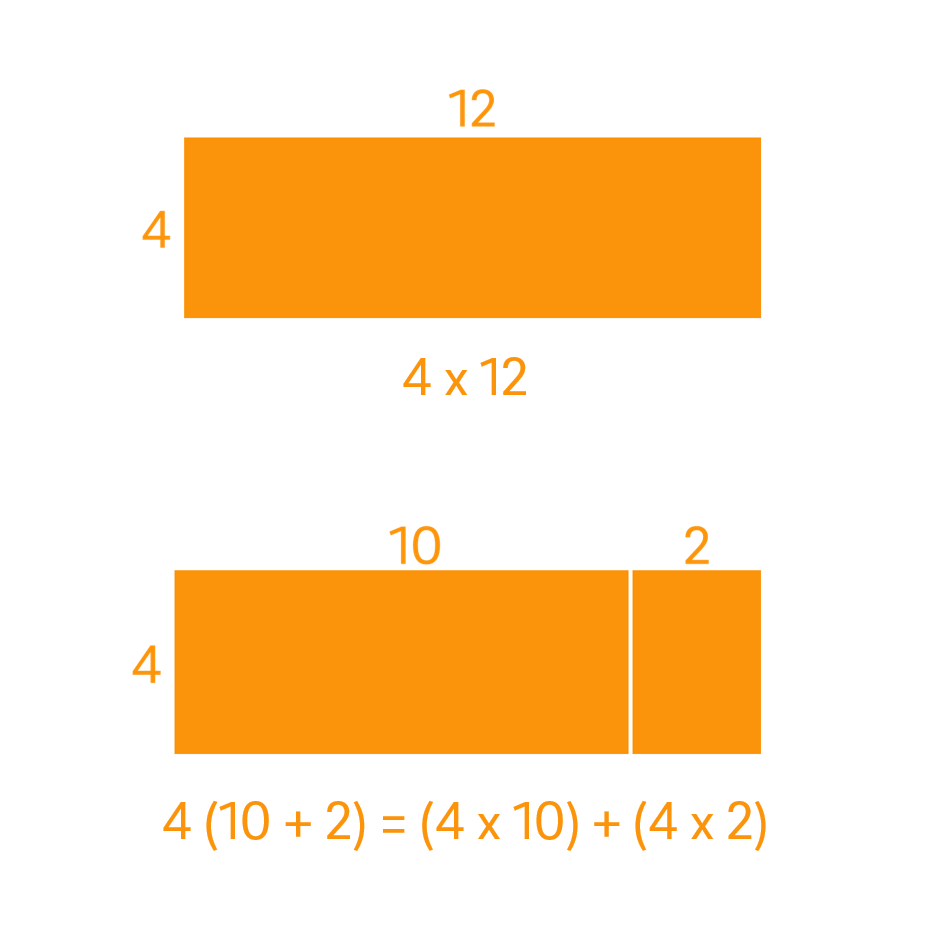
It is called the distributive property because the 4 is distributed across the 10 and the 2.
Students are asked to partition the array into smaller parts to solve this problem. They are being asked to apply the distributive property of multiplication. The distributive property is a fundamental arithmetic property of our number system.
In multiplication, numbers can be partitioned and distributed to make partial products. The partial products are then added together to find the original total of the multiplication. This is known as the distributive property of multiplication.
This can be expressed algebraically as:

Let’s consider the distributive property applied to $12 \times 4$:
12 can be partitioned into $10 + 2$. Each part is then multiplied by 4. The partial products formed are then added together to find the total.
This can be represented using following equation:
$$12 \times 4 = (10 \times 4) + (2 \times 4)$$

It is called the distributive property because the 4 is distributed across the 10 and the 2.
The focus of this discussion is to look at efficiency. Students will have partitioned the array in multiple different ways, with some strategies more efficient than others. Partitioning based on place value is typically the most efficient way to solve multi-digit multiplication problems.
Select some students to share the strategies they used to calculate the total number of bread rolls in the array. Model students’ strategies using an open array (area model) and record as an equation. The Model students' strategies professional learning embedded in this step illustrates how you might do this.
Discuss:
- How are the strategies used different, and how are they similar?
- Difference is seen in the way the array has been partitioned. Similarity is seen in the fact that the array is partitioned. This points to the multiplicative property of distributivity.
- Which way of partitioning the array was most helpful in calculating the total number of bread rolls?
- We need to consider the factors (that is, the numbers being multiplied) in the problem to decide which ways of partitioning are most helpful.
- Multiplication by whole tens is efficient and is also foundational to using the formal multiplication algorithm in later years. As the bread rolls are in smaller 4 x 6 arrays it is not immediately obvious that you can partition based on ten. Students should see that partitioning the array based on the place value parts of numbers is a helpful strategy.
Model students’ strategies

We want students to represent their thinking using multiple representations, and to see how these different representations are connected. Below are three examples of students’ strategies and how you might model students’ strategies using an open array (area model) and with an equation. These three strategies are different, yet similarities can be seen in the equations.
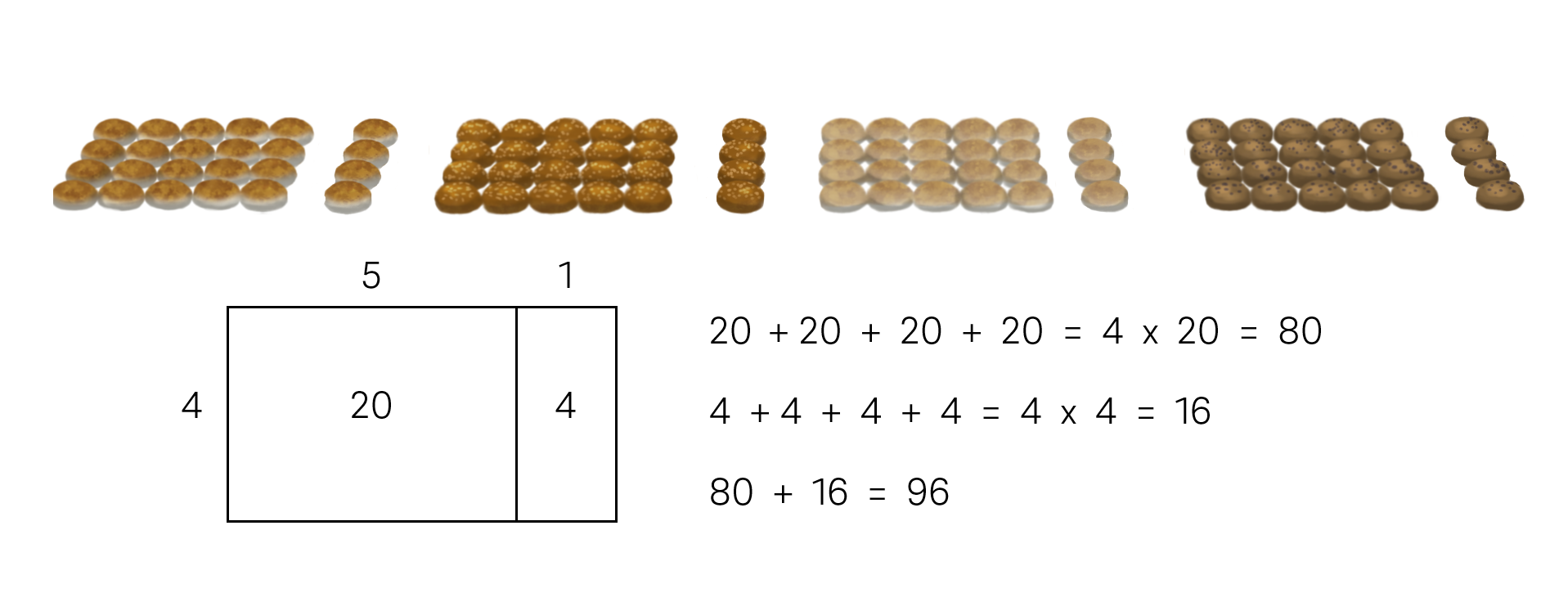
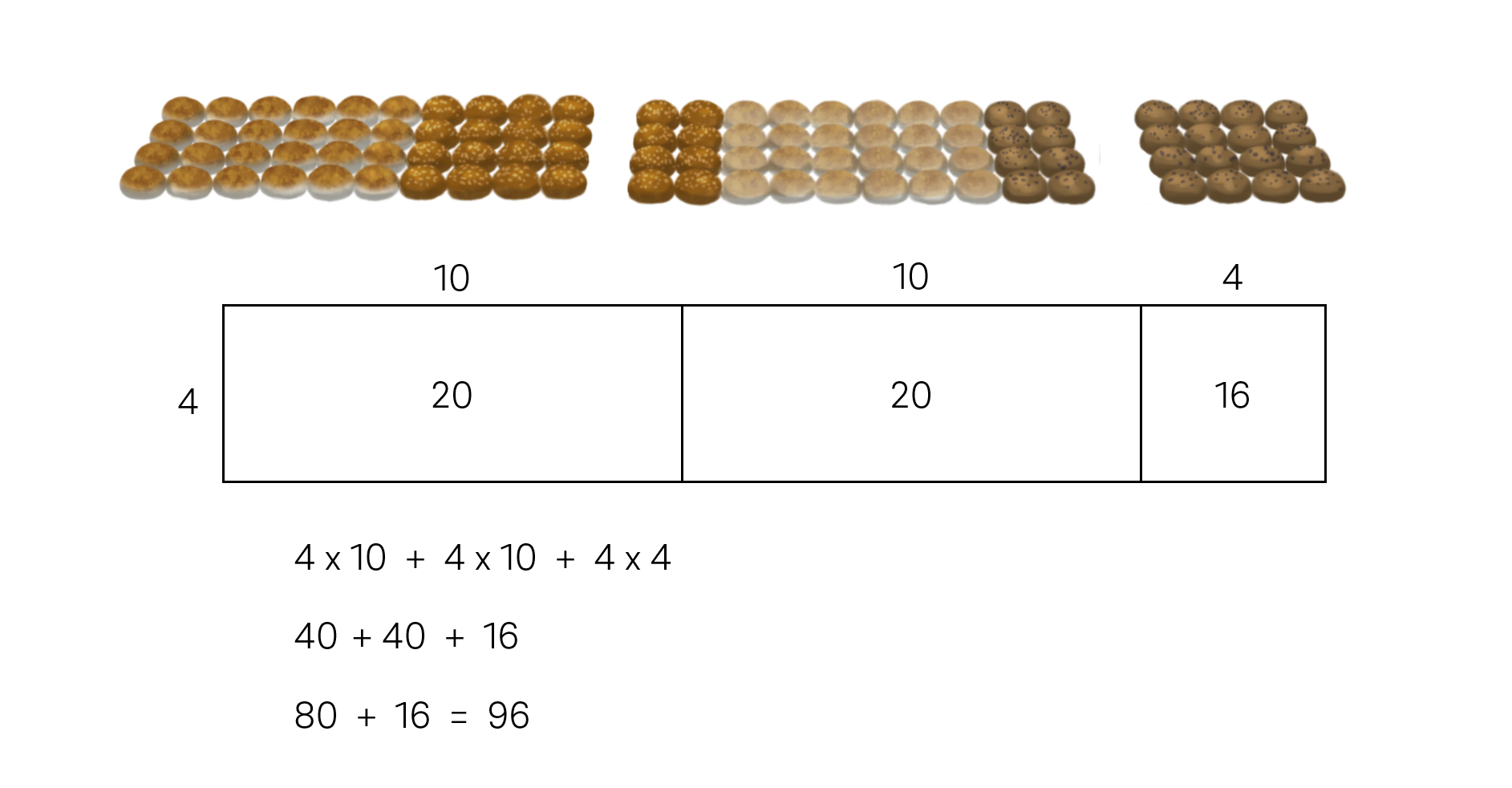

We want students to represent their thinking using multiple representations, and to see how these different representations are connected. Below are three examples of students’ strategies and how you might model students’ strategies using an open array (area model) and with an equation. These three strategies are different, yet similarities can be seen in the equations.



Explain: We can solve a difficult multiplication problem by partitioning factors to create smaller problems. Partitioning factors to create well-known multiplication facts, such as multiples of ten, is particularly helpful. The products of these smaller problems are then added together to find the product of the original problem.
Discuss with students the different ways that they partitioned the factors to create known multiplication facts, such as multiples of ten, to solve the problem.
Add to the class display using the students' posters from this task, using the summary statement from above as a title for the display.